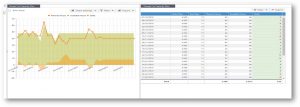
How rough is your rough-cut capacity planning?
Rough cut capacity planning (RCCP) is a technique supply chain companies use to gain insights on the future capacity requirements of their businesses. For instance, they might use it when investing in new plant, equipment, or distribution centres. Or it might come into play when allocating additional shifts.
Usually, RCCP supports the master production schedule, detailing future requirements for key resources such as labour, inventory space and machine time. Executives often associate it with supply chain optimisation. It’s a planning tool that helps them better marshal resources.
RCCP Scenarios
Let’s consider two RCCP scenarios to make the concept a little more concrete.
Scenario 1: A Rodent Mitigation Brand Low On Inventory Space
A rodent mitigation brand that sells pest repellent devices (such as ultrasonic noise emitters) suddenly experiences a supply chain shock that prevents it from shipping its products. For legal reasons, its logistics partners can no longer ship the stock in its warehouse to its target market, leading to an overstock situation.
In this case RCCP could help the company decide whether to expand its inventory space. As a forward-looking tool, RCCP lets the company look out six to twelve months and ask whether the investment in new capacity is worthwhile. If the shock is temporary (and not expected to repeat) then it is not.
Scenario 2: A Soy-Based Food Company That Requires More Production Capacity
A soy food brand selling tofu and tempeh saw a spike in sales. To meet demand, it had to increase hours worked. Given its expectation that sales would remain high (and possibly increase further), RCCP proved invaluable. The technique allowed the brand to map out planned hours versus available hours to see where any shortfalls might occur. Thus, it was able to predict labour squeezes in the future – part of its long-term production planning.
When To Use RCCP
Firms can use RCCP in the planning process – that is, before Materials Requirements Planning (MRP). This way, executives and managers can determine whether their plan is achievable and whether they will need to upscale or downscale plant and resources.
They can also use RCCP after Requirements planning. This way, they get a medium-term view of requirements, taking into account lead times and stock.
Throughout the process, there are opportunities to construct sales plan constraints. For instance, RCCP-using companies often discover that their plans could lead to capacity issues. Promotions and one-off deals may result in warehouse capacity issues or stock scarcity. RCCPs don’t force firms to avoid these risks – they simply allow them to weigh them against the potential payoffs. These constraints can then be fed back to the sales teams to consider their demand plans.
How Rough Is Your Rough-Cut Capacity Planning?
Rough cut capacity planning gets its name from the fact that it is often intuitive and preliminary. It focuses on the basics, eschewing hidden values and inventories to keep things as simple as possible.
But can you be a little too rough cut in your approach to RCCP? Arguably, yes. Ideally, you want your RCCP to encompass a minimum level of detail to permit adequate planning. Failing to meet this threshold of detail could deny you critical strategic insights.
When it comes to rough-cut capacity planning, you want to collect availability metrics in the following categories:
Stock Availability
RCCP requires knowledge of raw materials to hand and incoming via the supply chain, plus any part-finished stock on the line. You’ll need to calculate how many finished articles you can produce by a certain time, given your current resource position.
RCCP is helpful because it tells you whether you have the items available to satisfy demand. In addition, it allows you to identify bottlenecks. For instance, you might highlight difficulties in:
- Raw material availability
- Specific stages of your production process (leading to an excess of semi-finished goods)
- Finishing goods completion and distribution
Labour And Plant Availability
RCCP also allows you to identify potential upcoming labour and plant issues.
Skills matrices are helpful for working out if you have the people you need to run all aspects of your production line. Companies can get into trouble when two key players take time off at the same time, and nobody else in the firm has the skills to take their place. This can also raise the question as to whether cross-training within the skills matrix is required, to mitigate the situation in the future.
RCCP is also helpful for determining whether the change over time for machines is worth it.
Suppose, for instance, you are a pie brand, and you make two products: a standard meat and potato, and a premium version. Ideally, after finishing the value run, you’d like to adjust your production line to create packaging that reflects the premium line. However, RCCP might tell you that the costs of doing so outweigh the benefits.
For instance, switching to premium pie production might actually cost you more money than it will generate. So the profitable decision might be to sell premium products in regular packaging to retailers at your cost.
Space Availability
Lastly, RCCP comes in handy when planning space.
For instance, you might notice that you have the potential to make a large number of sales in the coming months. Perhaps consumer tastes are changing and a spike in demand is imminent.
RCCP can help by showing you whether you have shelving space to store all the additional goods in your warehouse. You might need to rent temporary storage or decide if it’s worth investing capital in a brand new distribution centre.
You can also use it for scenario planning. For instance, you can see what might happen to your space availability if you change your stocking strategy temporarily.
Where does this capability live in a planning IBP PLATFORM?
Insights from the RCCP naturally tie in with integrated business planning (IBP). For instance, the RCCP could shed light on:
- Whether it is worth training up more employees to operate parts of the production line (if two critical employees get sick at the same time)
- Whether you need additional warehousing to fit in with the forward business plan
- Whether you should change your product formulations to minimise the switching of lines.
Bottom Line
Now that you understand more about RCCP, you’re in a better position to determine whether yours is too rough or not. If you are a manufacturer who follows a make-to-stock workflow, then you’ll love the approach because it shows you how many goods you should be producing. Bespoke manufacturers won’t find it as helpful.
RCCP lets you optimise your business plan. You can use it to work out whether you should make investment decisions that could affect your overall strategy. A detailed approach can pay off long-term.



